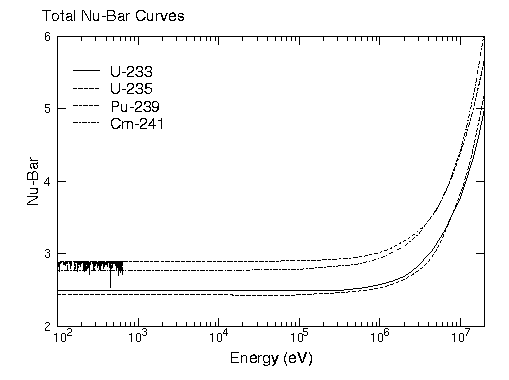|
The number of neutrons produced in a fission reaction is highly
important for fission reactors, explosive fission devices, and
the safe storage and processing of fissionable materials. It is
an energy-dependent quantity, and it has both prompt and delayed
components. Fission neutron yields, or "nu-bar's," are given
in three special sections of File 1:
- MT=452, total neutrons per fission,
- MT=456, prompt neutrons per fission, and
- MT=455, delayed neutrons per fission and time constants.
Upon fission, the excited nucleus formed by the target and the
projectile breaks up into two roughly equal "fission fragments"
and a number of additional neutrons (1, 2, 3, 4, ...). It is
the average over all these possible break-up modes that gives
the "prompt" nu-bar (e.g., 2.5). Some of the excited
fission fragments emit additional neutrons as they decay over
the next second or so; these are called "delayed neutrons."
Prompt nu-bar tends to be constant at low energies, and then it
gradually increases as the energy increases. In earlier times,
this increasing trend was often represented as a simple polynomial
(approximately linear) in energy E. More detailed analysis
shows more structure associated with second- and third-chance fission
processes. Some evaluations even have structure at very low
energies. Therefore, most modern evaluations use a detailed
tabulated function to represent the energy dependence of the
fission nu-bar. The following figure shows a few examples:
|

